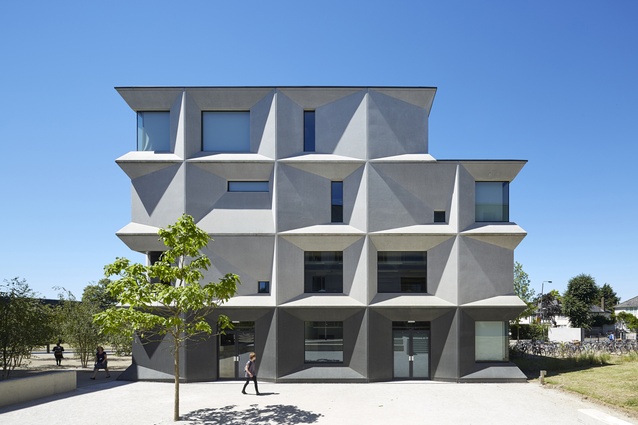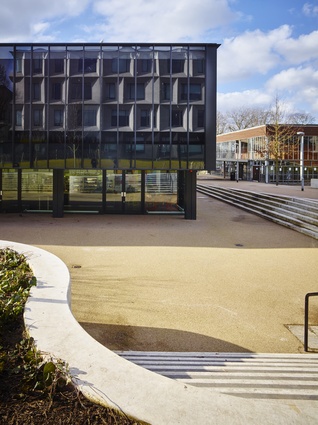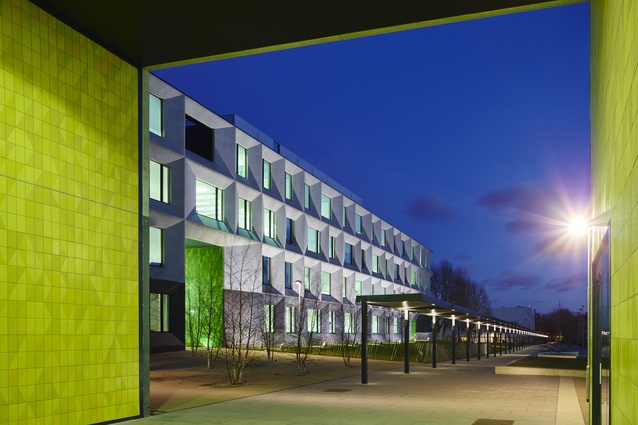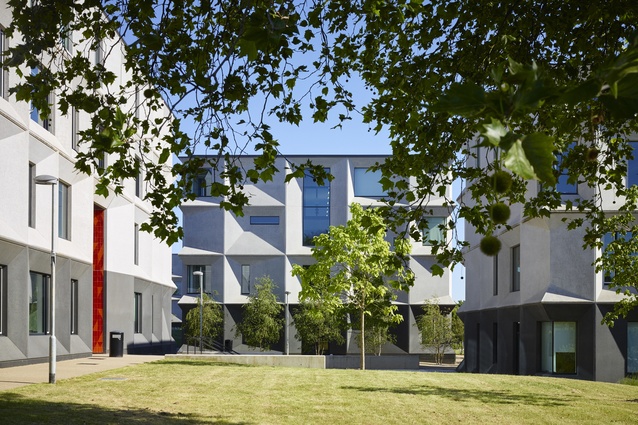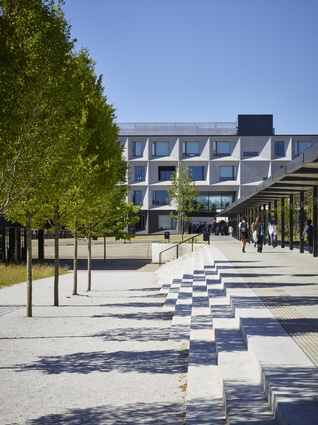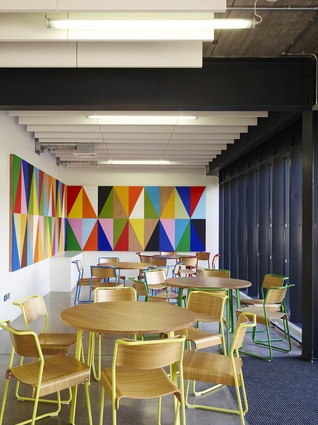Stirling effort leads to success
Update: Burntwood School, a comprehensive girls school in Wandsworth, London, has won the UK's most prestigious architectural award: the RIBA Stirling Prize. Designed by Allford Hall Monaghan Morris (AHMM), the transformation of the school mixes contemporary art and design with innovative reuse.
Originally a 1950s modernist campus with buildings designed by renowned architect Sir Leslie Martin, AHMM have introduced six new faculty and two large cultural buildings that feature a vast amount of natural light and air, adding large colourful murals to enhance the already sculptural feel of the building.
The RIBA judges commented, “Burntwood School is the clear winner of the 2015 RIBA Stirling Prize. It is the most accomplished of the six shortlisted buildings because it demonstrates the full range of the skills that architects can offer to society.
"It encompasses great contemporary design and clever reuse of existing buildings as well as superb integration of artwork, landscaping and engineering. It is a genuine collaborative project. There was a wonderful working relationship between the head teacher and the architect: a true partnership of equals."
See below for ArchitectureNow's original interview with Daniel Lewis on Burntwood School.
Recently returned New Zealand architect Daniel Lewis worked for London-based architectural firm Allford Hall Monaghan Morris (AHMM). Lewis formed part of the senior team responsible for the design of Wandsworth’s Burntwood School – a project that has made AHMM one of six finalists for [and eventual winner of] the UK’s highest architecture accolade: the Stirling Prize. The winner will be announced at a ceremony in London this Thursday, October 15 (Friday morning New Zealand time).

Federico Monsalve: Where were you born and did you study and practice architecture locally before going to the UK?
Daniel Lewis: I was born in Nelson, and raised in the Moutere Hills of rural Tasman Bay. I studied at the School of Architecture, University of Auckland. Then I worked and got registered at Daniel Marshall Architects in Auckland before departing for the UK.
FM: What was your role in the Burntwood School project?
DL: I was the project architect on Burntwood School, working with our director Paul Monaghan and associate director Ben Gibson, leading the AHMM team on a day-to-day basis. This included coordinating with the consultant team, getting involved in some stakeholder design presentations, liaising with the design-and-build contractor who was our client, as well as with their sub-contractors. My involvement was from the early stages of the concept design competition through planning consent, detailed design documentation, sub-contractor coordination and shop drawing review and site observation.
FM: Burntwood School has been awarded the Civic Trust Award 2015, New London Architecture Award Education 2015, RIBA London Region Award 2015, RIBA National Award 2015, Concrete Society Award 2014, Wandsworth Design Award 2014, and now has now been shortlisted for the RIBA Stirling Prize 2015.
There are probably hundreds of factors that have aligned to contribute to the success of the design, but can you tell us just a few?
DL: It certainly helped that the previous school was designed by the London County Council architect Sir Leslie Martin, and it set a precedent for excellence - although it was rather tired by the time we got there and lots of facilities were no longer fit for purpose. The campus master plan had a simple elegance that worked well: two large teaching blocks were demolished as well as some smaller pavilion buildings. The existing hall and the pool building were retained with the new scheme adding six new buildings.
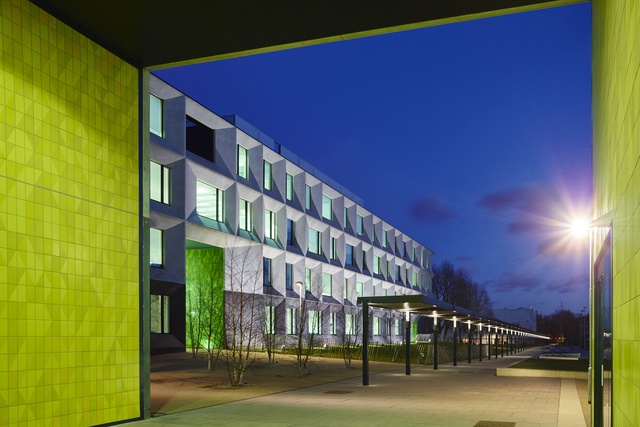
The site master plan has an orthogonal layout: buildings sliding past and aligned corner-to-corner with each other to create spaces between that are varied and individual. This simple layout of these buildings, combined with the pedestrian spine that runs the length of the site, has naturally good way-finding with a site layout that is easy to navigate.
The precast concrete cladding panels we used on the Teaching Blocks are solid and beautifully crafted, imbuing a sense of quality and permanence. The form and scale are memorable, and of a quality that creates a sense of place with which the users quickly become familiar and proud.
Additionally, Burntwood’s senior teaching staff was well-versed in good design – no doubt due to the quality of the buildings they had worked in previously. The staff strongly advocated for good architecture and assisted in promoting this for the benefit of the staff, students and community.
FM: What about the interiors? Is there anything that you feel is particularly noteworthy?
DL: The common spaces of the Teaching Buildings are particularly evocative: the double-height entrances, the stairs, the double- and triple-height breakout spaces; and the central corridors that mostly run the full length of the buildings, terminating in windows. The spaciousness and connection to the landscape of these corridors through the end windows, and the adjacent breakout spaces, makes what could have been quite dreary central corridors into light-filled spaces. Through their connection to the landscape, these spaces make way-finding more legible.
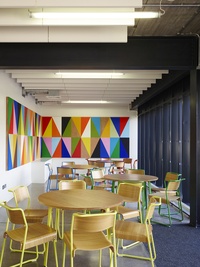
FM: Allford Hall Monaghan Morris is known for its award-winning educational facilities. In your opinion – or research – how does architecture influence education?
DL: Allford Hall Monaghan Morris is indeed experienced and successful with educational buildings. I believe that quality architecture inspires the occupants to similarly strive for quality outcomes in their own education or work. Beyond my subjective observations are the specific technical research that draws links between such things as fresh air quality, natural light and acoustics, and the subsequent educational outcomes.
FM: What has drawn you back to New Zealand and what are you hoping to achieve?
DL: I love London and Europe - but New Zealand/Aotearoa is my home, my whenua, and I belong here. I had a strong sense of that personally and professionally as after seven years in London I decided to return. New Zealand (and in particular Auckland) is at an exciting point. A lot can be learned from Europe in regard to our need for medium-density housing, improved public transport and great amount of quality public urban places (streets, squares and parks).
I’m excited about developing models that take the best from around the world and make local solutions that acknowledge our culture and climate. At TOA Architects we talk about ‘kaitiaki’: being guardians of our clients’ and communities’ projects. But we also talk about ’cutting new ground’: looking back and understanding the context, whilst also moving forward, is how I like to work. Working with clients and communities on projects that have this depth of thought and achieve world-class outcomes is something I believe we can achieve.
A full interview with Daniel Lewis will appear in the December 2015 issue of Interior magazine.

